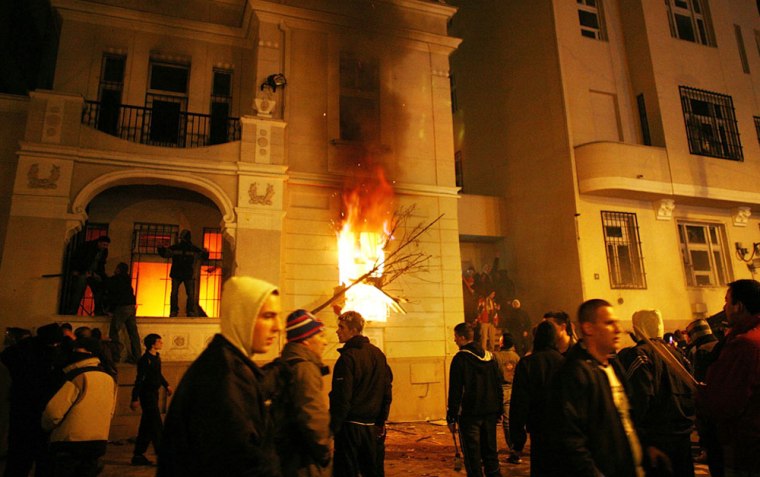Despite an intensive $4-billion drive to protect U.S. embassies against violence, at least 150 American missions abroad still fall short of security standards put in place after deadly bombings, The Associated Press has learned.
And it will cost twice that amount to replace or renovate just the most vulnerable of them, according to documents reviewed by the AP.
The push to secure U.S. diplomatic missions began in earnest after bombings of the American embassies in Kenya and Tanzania a decade ago, assaults that killed 231 people, including 12 Americans. The security effort took on new urgency after the Sept. 11, 2001, attacks in the U.S., which led to government-wide vulnerability reviews.
The results so far suggest there's a long way to go to bring all the roughly 265 U.S. embassies and consulates up to standard.
The State Department says it will need about $7.5 billion to construct new buildings at around 50 posts and $850 million for "major rehabilitation" at 40 others through 2013. The figures are contained in the department's Long-Range Overseas Buildings Plan that was sent to Congress last week.
In addition, about 60 other embassies and consulates will need to be replaced or will require substantial work by 2018, according to documents accompanying the 450-page plan, which is labeled "sensitive but unclassified" and not to be shared with foreign governments, according to officials familiar with its contents.
U.S. diplomatic posts fly the Stars and Stripes in capitals around the globe and are among the most high-profile overseas targets for terrorists and protesters. From Baghdad to Beijing to Belgrade, they are lightning rods for violence that has claimed the lives of dozens of diplomats over recent decades.
This year alone, embassies in Bolivia, Chad and Serbia have been attacked or overrun, not to mention the frequent barrages of rocket fire that have landed near the U.S. Embassy in Iraq.
The long-range plan is not a formal request for funding but more like a wish-list of projects deemed critical by experts in the State Department's real estate, security and regional bureaus. It is updated annually, but action on this year's list is not expected until after the next administration takes office in January.
Nearly all of the facilities identified fail to meet at least some of the strict security requirements implemented after the East Africa bombings, officials said. Those include setting buildings significantly back from major roads and reinforcing walls and windows.
New measures still not enough
Since 9/11, the Bush administration has pumped $4.1 billion into embassy and consulate construction, building 57 new facilities that do meet the security specifications. On top of that, the State Department spends about $100 million a year in security upgrades for the more that 16,100 properties it manages around the world.
But the officials say even that major effort has not been enough to ensure the safety of U.S. diplomats abroad, especially as construction costs have been rising and the U.S. dollar has declined against foreign currencies.
"It really has not yet put us where we have to be," Richard Shinnick, director of the department's Bureau of Overseas Buildings Operations, said in an interview. "We have important protective responsibilities."
In many cases, that means embassies must be relocated from downtown locations in world capitals to outlying areas, even suburbs.
Secretary of State Condoleezza Rice and her predecessors have all made the physical security of State Department personnel, particularly in their work places, a top priority.
But the department's current plans for new construction are unprecedented in scope in both the private and public sectors, with the possible exception of the military.
"Nobody else is building at this rate," said Shinnick, a former New York City firefighter and senior diplomatic manager who was brought out of retirement this year to run the State Department's $14 billion real estate empire.
He replaced Gen. Charles Williams who stepped down under heavy criticism for repeated delays and problems in the construction of the new U.S. Embassy in Baghdad that will cost $736 million, including additions to the original design. The State Department took legal possession of the Vatican-sized, heavily fortified embassy compound in April.
Neither Shinnick nor the other officials would discuss specific problems at any embassies or consulates or identify any locations for security reasons.
But a look at facilities the State Department is opening this year, now under construction or set to go to bid, offers a glimpse of the scale of the long-range plan.
In the current budget year that ends on Sept. 30, the department told Congress in February that it had opened already or would open at least 11 new buildings. Those are the "three Bs" — Baghdad, Beijing, Berlin — as well as Bogota, Colombia; Ciudad Juarez, Mexico; Khartoum, Sudan; Kigali, Rwanda; Mumbai, India; Skopje, Macedonia, and Quito, Ecuador.
Department documents reviewed by the AP identify 26 other posts at which new embassies, consulates or offices are currently either under construction or in the advanced design stage.
Those include projects in Abuja, Nigeria; Addis Ababa, Ethiopia; Guangzhou, China; Jiddah, Saudi Arabia; Jerusalem; Johannesburg, South Africa; Karachi, Pakistan; Manila, Philippines; Port-au-Prince, Haiti, and Sarajevo, Bosnia-Herzegovina.
An additional 19 projects are slated to go to bid this year and next, including new buildings in Baku, Azerbaijan; Bangkok, Thailand; Belgrade, Serbia; Bucharest, Romania; Dakar, Senegal; Dubai, United Arab Emirates; Kabul, Afghanistan; Kiev, Ukraine, and Pretoria, South Africa, according to the documents.
Not on those lists, but among the facilities regularly identified as needing improvements is the U.S. Embassy in London. A decision on whether to renovate the London property or sell it and build a new embassy could be made within months.
